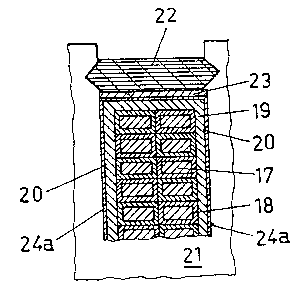Some of the information on this Web page has been provided by external sources. The Government of Canada is not responsible for the accuracy, reliability or currency of the information supplied by external sources. Users wishing to rely upon this information should consult directly with the source of the information. Content provided by external sources is not subject to official languages, privacy and accessibility requirements.
Any discrepancies in the text and image of the Claims and Abstract are due to differing posting times. Text of the Claims and Abstract are posted:
| (12) Patent: | (11) CA 2094340 |
|---|---|
| (54) English Title: | CORONA-SHIELDING ARRANGEMENT FOR THE STATOR WINDING OF AN ELECTRIC MACHINE |
| (54) French Title: | DISPOSITIF ANTI-EFFLUVES PAR ENROULEMENTS DU STATOR DE MACHINES ELECTRIQUES |
| Status: | Expired and beyond the Period of Reversal |
| (51) International Patent Classification (IPC): |
|
|---|---|
| (72) Inventors : |
|
| (73) Owners : |
|
| (71) Applicants : |
|
| (74) Agent: | NORTON ROSE FULBRIGHT CANADA LLP/S.E.N.C.R.L., S.R.L. |
| (74) Associate agent: | |
| (45) Issued: | 2002-10-15 |
| (22) Filed Date: | 1993-04-19 |
| (41) Open to Public Inspection: | 1993-12-11 |
| Examination requested: | 2000-04-06 |
| Availability of licence: | N/A |
| Dedicated to the Public: | N/A |
| (25) Language of filing: | English |
| Patent Cooperation Treaty (PCT): | No |
|---|
| (30) Application Priority Data: | ||||||
|---|---|---|---|---|---|---|
|
The corona-shielding arrangement for the stator
winding of an electric machine, comprising a semi-
conductive textile corona-shielding strip wound around
the major insulation of slot portion and end yoke
portion of each bar of the stator winding is con-
structed such that the slot portion (10) of the stator
winding bar is wound around in at least one layer with
a first semiconductive, volume-conducting corona-
shielding strip (24) having an approximately constant
degree of overlap. The end yoke portion is wound around
in at least one layer with a second semiconductive,
volume-conducting corona-shielding strip (24), the
degree of overlap from the exit of the bar from the
stator body (14) to the bar end becoming continuously
smaller.
This corona-shielding arrangement is economic
to produce; the voltage characteristic in the longitu-
dinal direction of the bar is simple to optimize.
Note: Claims are shown in the official language in which they were submitted.
Note: Descriptions are shown in the official language in which they were submitted.

2024-08-01:As part of the Next Generation Patents (NGP) transition, the Canadian Patents Database (CPD) now contains a more detailed Event History, which replicates the Event Log of our new back-office solution.
Please note that "Inactive:" events refers to events no longer in use in our new back-office solution.
For a clearer understanding of the status of the application/patent presented on this page, the site Disclaimer , as well as the definitions for Patent , Event History , Maintenance Fee and Payment History should be consulted.
| Description | Date |
|---|---|
| Time Limit for Reversal Expired | 2004-04-19 |
| Letter Sent | 2003-04-22 |
| Grant by Issuance | 2002-10-15 |
| Inactive: Cover page published | 2002-10-14 |
| Inactive: Final fee received | 2002-07-29 |
| Pre-grant | 2002-07-29 |
| Notice of Allowance is Issued | 2002-02-04 |
| Notice of Allowance is Issued | 2002-02-04 |
| Letter Sent | 2002-02-04 |
| Inactive: Approved for allowance (AFA) | 2002-01-09 |
| Letter Sent | 2000-04-27 |
| Inactive: Status info is complete as of Log entry date | 2000-04-27 |
| Inactive: Application prosecuted on TS as of Log entry date | 2000-04-27 |
| Request for Examination Requirements Determined Compliant | 2000-04-06 |
| All Requirements for Examination Determined Compliant | 2000-04-06 |
| Application Published (Open to Public Inspection) | 1993-12-11 |
There is no abandonment history.
The last payment was received on 2002-03-28
Note : If the full payment has not been received on or before the date indicated, a further fee may be required which may be one of the following
Please refer to the CIPO Patent Fees web page to see all current fee amounts.
| Fee Type | Anniversary Year | Due Date | Paid Date |
|---|---|---|---|
| MF (application, 5th anniv.) - standard | 05 | 1998-04-20 | 1998-03-23 |
| MF (application, 6th anniv.) - standard | 06 | 1999-04-19 | 1999-03-22 |
| MF (application, 7th anniv.) - standard | 07 | 2000-04-19 | 2000-03-17 |
| Request for examination - standard | 2000-04-06 | ||
| MF (application, 8th anniv.) - standard | 08 | 2001-04-19 | 2001-03-27 |
| MF (application, 9th anniv.) - standard | 09 | 2002-04-19 | 2002-03-28 |
| Final fee - standard | 2002-07-29 |
Note: Records showing the ownership history in alphabetical order.
| Current Owners on Record |
|---|
| ASEA BROWN BOVERI LTD. |
| Past Owners on Record |
|---|
| ROLAND SCHULER |